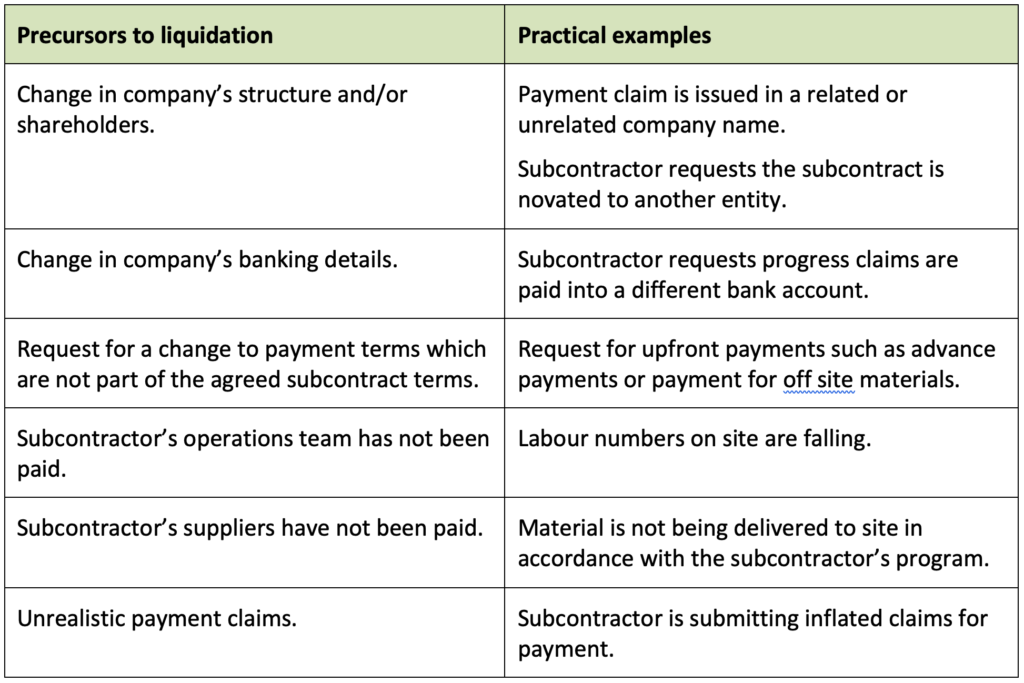It is an unfortunate and unavoidable fact that with supply and pricing as volatile as it currently is, the risk of insolvency within the industry is very real. In this article, Amy Rutherford, a construction partner at Greenwood Roche project lawyers, provides contractors with practical tools when faced with potential subcontractor insolvencies — in particular, common warning signs, how to prepare for a subcontractor insolvency, and some practical tips (outside obvious legal recourse) once a subcontractor insolvency is confirmed.

Practical tools: Preparing for insolvency
There are one or two very loud warning signs that a subcontractor may be experiencing financial distress.
These warning signs can occur over a number of weeks or within quick succession. In the time available, there are a number of actions you can take to best prepare for such an insolvency:
• Review the subcontractor’s security: is it cash retention and/or bank guarantee? Ensure the correct amount (as set out in the subcontract) is being held. If security is in the form of a bank guarantee, has it been executed correctly and is it enforceable? Can you substitute bank guarantees for a cash retention (if your subcontract allows it, cash is generally the safer option instead of allowing an institution (ie bank or insurance company) the power to refute a call on a bank guarantee).
• Meet with the subcontractor to express your concerns on progress and seek confirmation on mitigation actions to maintain the programme. Minute all meetings and circulate to all relevant parties.
• Maintain clear records of the subcontractor’s progress, such as site diaries and progress photos for example.
• Commence informal discussions with alternative subcontractors if the head contract critical path is at risk. Or consider if self-delivery is an option, and create a back-up plan.
• Understand the subcontractor’s sources of materials in order to directly purchase materials in the event of subcontractor insolvency. Does the subcontract allow you to make payment directly to sub-subcontractors and suppliers?
• Do not over-certify progress claims. Certify and pay for works completed to date. Beware of the Construction Contracts Act (if applicable). If a payment schedule is not issued on time and in accordance with the subcontract the amount may be claimed by the subcontractor as a debt due, and the opportunity to set off or dispute the relevant progress claim is lost.
Action following confirmation of insolvency
Once insolvency has been confirmed, immediately obtain specialist insolvency legal advice and, in addition:
• Follow the subcontract insolvency mechanism, e.g. issue a letter of termination.
• Quantify the monies owing to or from the subcontractor as determined by the subcontract (incorporating subcontract works completed at the date of insolvency and your liability to pay, extra over costs of a replacement subcontractor and/or purchasing materials directly from the subcontractor’s suppliers, defects, legal costs of dealing with the insolvency etc), and advise the subcontractor in writing immediately. If you need to call on a bank guarantee for example, you must have provided the subcontractor with an account statement prior to any such call.
• Put the subcontractor’s account on hold to ensure no further payments are made.
• Consider your exposure under the head contract in terms of time and cost — can this be mitigated?
• Ensure there is appropriate site security to minimise the risk of any material and plant being removed from site by the subcontractor’s disgruntled creditors or the subcontractor.
• Await contact from the relevant administrator.




